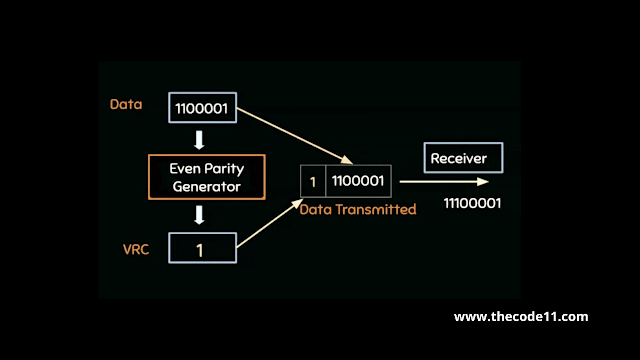In this tutorial you are going to learn about Vertical Redundancy Check in Computer Networks. You will learn about various types of error detection methods, understand VRC and its performance.
Vertical Redundancy Check (VRC)
VRC stands for Vertical Redundancy Check. It is also known as parity check.
Example:
Suppose, if 1100001 is the data that we would like to send to the receiver. In other words, let 1100001 be the data the sender generates. It is of seven bits, 1100001 and this is obviously the data that is generated by the sender. Now, this data is given to the even parity generator.
An even parity generator accepts this data and generates a parity bit. This even parity generator checks for the number of ones that are there in the data after accepting it. There are three ones and three is an odd number. So it creates the VRC, that is the redundant bit, which is called as a VRC bit as 1 here because, this 1 indicates that there are an odd number of 1’s in the data. Odd number of ones mean, there may be only one-one in the data or three 1’s, or five 1’s, or seven 1’s.
Now in this case, there are three 1’s so it generates one as the parity bit. This parity bit is also called as a redundant bit and here, it is called a VRC bit or parity check. It appends this one with the data and sends that to the receiver. So the data that is transmitted is 11100001.
We can notice in the data transmitted, 1100001 is the original message and 1 is the VRC. Now, this is what the information is sent to the receiver. If there are no errors during transmission, the receiver receives this information as 11100001. After receiving, the receiver checks for even number of ones in the received message. If there are even number of ones in the received message, the receiver understands that there are no transmission errors. Whereas, if the receiver sees that there are odd number of ones in the data that it has received, it understands that the message was prone to transmission errors and it rejects this.
Simply, it means that the receiver knows this bit will be the parity bit. So, it places this bit aside and checks for the number of ones in the actual message. In this case, there are three 1’s and it knows three means it is an odd number. So it checks for the parity bit whether it is one or zero. For three, if it is one here, the receiver understands that there are no transmission errors. Though, this VRC is a very simple process, but there are serious drawbacks with the VRC.
Performance of VRC
There are two types of errors. One is the bit error and the other one is the burst error.
- It can detect single bit errors. It means, if only one bit that has been changed during transmission, VRC is very powerful enough in detecting the errors. The probability of having bit errors during transmission is very minimal. So there are chances for burst errors.
- It can detect burst errors only if the number of ones is odd.
| Sender: 11100001 -> Transmission Error 10100001 -> Receiver rejects this data. |
In the above example, we assume that the sender is creating the message 11100001. It means, 11100001 is what the original message is, i.e., the parity bit. Now, this message is transmitted over the transmission medium and let's assume that the second bit is modified as zero. Now, the receiver receives 10100001 and it checks whether there are even number of 1’s in the message that it has received. In this case, there are only three 1’s. It means it receives odd number of 1’s. So the receiver rejects this data or the message because it accepts only even number of 1’s.
| Sender: 11100001 -> Transmission Error 10100101 -> Receiver accepts this data. |
In the above example, two bits are changed, that is the second bit is modified and the sixth bit is also modified. In this case, the number of errors is an even number. If the receiver receives this data the receiver checks for even number of 1’s. Since it has received even number of 1’s, the receiver misunderstands that there are no errors in the transmission and therefore it accepts the data. But actually, this message is erroneous. If the number of errors is odd, VRC can detect but if the number of errors is even, VRC cannot detect this.
This article on Vertical Redundancy Check in Computer Networks is contributed by Rajnish Kumar. If you like TheCode11 and would like to contribute, you can also write your article to us. Here is our mail id - thecode11info@gmail.com


